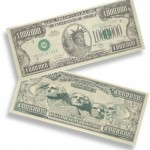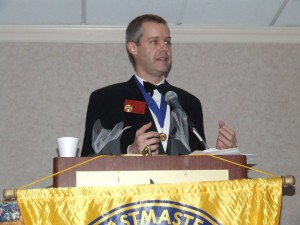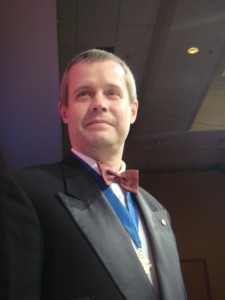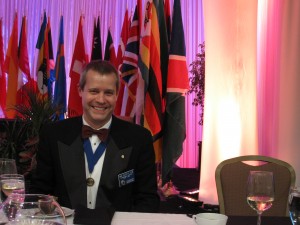 Thanks to the archives of Past International Director Rick Sydor, my list of presidential citations now goes back to 1976, except for 1998-2002. Anyone have those?
Thanks to the archives of Past International Director Rick Sydor, my list of presidential citations now goes back to 1976, except for 1998-2002. Anyone have those?
Category: international convention
Toastmasters Presidential Citations
 Oddly, there’s no place on the TI web site listing who’s been awarded with Presidential Citations, presented at the August convention. I have the Hall of Fame booklets going back to my first convention in 2003, so I typed them up and attach them here, ten years history. Hopefully, World Headquarters will consider expanding this list and publishing it like the list of past International Presidents and World Champions of Public Speaking.
Oddly, there’s no place on the TI web site listing who’s been awarded with Presidential Citations, presented at the August convention. I have the Hall of Fame booklets going back to my first convention in 2003, so I typed them up and attach them here, ten years history. Hopefully, World Headquarters will consider expanding this list and publishing it like the list of past International Presidents and World Champions of Public Speaking.
What’s it cost to run for Second Vice President?
 Similarly to when I ran for ID, I’m going to publish what it cost to run for Second Vice President, for the benefit of anyone who may follow in my shoes. Here’s the entry for the ID costs.
Similarly to when I ran for ID, I’m going to publish what it cost to run for Second Vice President, for the benefit of anyone who may follow in my shoes. Here’s the entry for the ID costs.
The first step was the announcement at the end of the August 2010 convention. I was an outgoing director, so the convention registration and hotel costs were reduced; most would probably not count that as part of the campaign. However, I had announcement cards to hand out on Saturday night, since that would be my only chance to see most of the voters before the next annual convention. 2,500 cards cost $126 (M13 Graphics is great!).
I made a strategic decision to not attend any district conferences other than my own district. The campaign rules limit me to attending only Toastmasters events in my home region, and I already had good relationships with the leaders in all eight districts. I felt the expensive weekends that might be spent on those would be better used to reach out to other districts with phone calls. This meant I had essentially zero travel costs (other than the convention itself), a sharp contrast to my ID campaign (which was mostly travel costs, within the region).
Continue reading “What’s it cost to run for Second Vice President?”
Messages heard at the annual convention
 I met with over 60 districts during five days (it was quite a marathon, at 20 minutes each for 4-6 hours at a time on end), and there were some common and reasonable concerns I’d like to document here.
I met with over 60 districts during five days (it was quite a marathon, at 20 minutes each for 4-6 hours at a time on end), and there were some common and reasonable concerns I’d like to document here.
- We need some form of club officer training for distant clubs. I believe we could set a policy limiting it to clubs 50 miles or more from any district-sponsored training (so the majority of clubs would continue to attend the existing face-to-face training). The distance training could either be an interactive videoconference with existing district training (as D21 has been piloting for three years), or it could be WHQ-produced computer-based training. For the latter, it would need to be participatory, asking questions of understanding along the way (but not a “test”), so someone doesn’t just hit “play”, go do their laundry, and come back an hour later, all “trained”. Also, I think it would be reasonable to require that all seven officers be trained if the club chooses this option. Continue reading “Messages heard at the annual convention”
Running unopposed?
 Running for Second Vice President is an interesting experience for me, particularly running against other candidates. Of course, running for a world-wide office is considerably different from running at the district level. When I was Area Governor, I was appointed, and for Division Governor, I was unopposed.
Running for Second Vice President is an interesting experience for me, particularly running against other candidates. Of course, running for a world-wide office is considerably different from running at the district level. When I was Area Governor, I was appointed, and for Division Governor, I was unopposed.
When I ran for Lt. Gov’r Marketing (LGM), there were two other candidates (rare in my district!), and I took it pretty seriously. I developed a tri-fold brochure and a small poster to take to all the division contests, and the other two candidates were at all the same contests with a flier as well.
At the election, I gave a two-minute speech, and I honestly don’t remember a word of it at this point, but I guess I got through it (I was an ATM-B at the time). No one got a majority at the first vote, it took a second vote before I got a slight majority (64-61, I think). It really was a great experience!
As is typical, I was unopposed for Lt. Gov’r Education and District Governor (photo above). When I announced for International Director, someone else also announced, but a couple of months later, he dropped out due to a huge increase in responsibility at work.
However, I still ran it as if I were opposed, hitting 11 out of 16 district conferences in the region in the fall and spring (the others were on conflicting dates). I had a professional photograph taken, did a tri-fold brochure and a posterboard to take to conferences, and built a web site. I had intended to set the campaign up as a High Performance Leadership project, but I have to confess that when I became unopposed, I didn’t follow through on that idea.
In many ways, I regret that no one was running against me. I believe a little friendly competition can bring out the best. Still, I have a chance to do that now, as there are at least three other people, all incredibly talented, also running for Second Vice President.
I really enjoyed handing out the announcement cards at the end of the Palm Springs convention last month. It gave me a chance to confirm what some people were suspecting, and I had some fascinating (though brief) conversations. It was my last opportunity to see most of these Toastmasters leaders face to face before the convention in Las Vegas next August!
I will be reaching out to Toastmasters leaders in the coming months with personal phone calls (campaign rules sharply limit my use of other means), and I look forward to finding out more about what YOUR concerns are, where we’re doing well, what we can improve upon, and sharing my ideas about future directions.
Please feel free to contact me directly (details are at the bottom of my site’s home page), or if appropriate, just add a comment on my blog here, I’ll reply!
Why three votes for Second Vice President?
This year’s annual business meeting (Saturday, Aug. 14, 2010) went on for more than four hours, almost entirely due to the time required to count votes, most especially for holding two extra votes for Second Vice President.
There’s an easy solution to this. Well, two solutions:
- Move to an electronic voting method.
- Use preferential voting.
The electronic voting can be done in many different ways, but I would recommend a solution similar to how many states hold elections today, with an optical scan voting system, where the voters fill in a bubble or connect a line on a paper ballot to indicate their preferences. This process is simple, requires no expensive electronics in the voters’ hands, and can be easily audited afterward.
Preferential voting is the key though, and it’s something we already use — for speech contests! Speech contest judges mark their first three choices, and tie-breakers rank all the contestants. We can do the same thing in our elections, especially with electronic vote counting. When a “re-vote” is needed, the computer ballot scanner can do so automatically (and instantaneously), ignoring the dropped candidate. (You could do preferential vote counting by hand, but it would be laborious, having to examine each ballot and skip any dropped candidates for the voter’s next choice.)
With the International Leadership Committee (ILC) from Global Representation and Support bringing us more and more qualified candidates, multiple re-votes will be more and more common. Without these improvements, we’ll face interminable business meetings, waiting for results and then voting yet again on the candidates. Putting these steps in place will also allow the ILC (and RLCs?) to be more comfortable with presenting the voters with three choices to consider, instead of just two.
By simplifying the election process to a single ballot, we might even achieve Parliamentarian Herb Nowlin’s dream of an election with no spoiled or illegal ballots!
Annual business meeting proxy returns by district
It’s always interesting to see how seriously the districts take the business of collecting proxies from the districts. With the new electronic process for processing proxies, we hit a record high average (68.5%), well above previous years (52.4% last year and 48.9% the year before).
But how did individual districts do? I’m proud to say that my home district had 92.0% of their clubs represented (missing just 15 proxies) and ranked 4th. D50 set the mark with 95.3% (all but 7 clubs!). D54 and D49 were 2nd and 3rd, each missing just 4 clubs (they’re much smaller districts).
At the other end of the spectrum, those districts with the most room for improvement start with D34 (just 13.9% of clubs represented), D87 (28.5%) and D81 (36.7%). Just six districts were under 50%, and 46 were over 70%!
Full details in the Excel file here: ProxyReturns
Sunday: Back home
The scene at my Sunday morning flight’s gate at the Palm Springs airport was quite interesting; most of the people were Toastmasters! Including Jana, who declared as she boarded the plane “No speeches on this plane!”
It was a long trip home, via Dallas, but fortunately, I got upgraded on the last segment home to Chicago. It’s good to be home, but I’m already missing all my Toastmasters friends!
Soon it will be time to start calling them though, it’s just 2 1/2 months until the ILC starts their International Officer Candidate Survey (IOCS)!
Saturday evening: President’s dinner dance
 Tonight was the installation of the new board, Pat Johnson’s presidential address, and the formal beginning of my campaign.
Tonight was the installation of the new board, Pat Johnson’s presidential address, and the formal beginning of my campaign.
The installation concluded my service on the board, and Poh Kim Siong and I exchanged Past International Director pins. Pat’s address gave a review of how she got involved in Toastmasters and how we can all contribute.
The moment that Jana gaveled the convention to a close was when my work began, though. That was the signal that candidates could begin their campaign in earnest in the hall outside the ballroom, as people left.
I brought 2,500 cards to the convention, and I think I must have given out 1,800 of them. I received so many comments like “I thought you would run, and I’m so glad you are!”, it was great!
 I couldn’t have made it through without my campaign team, most especially my campaign manager, PID Joan Diehl, and Joe Esler. This was my last opportunity to meet most of these people face-to-face until the next convention in August, 2011. The dancing didn’t stop until 1 AM, and I stayed to make sure I had a chance to meet every single person there.
I couldn’t have made it through without my campaign team, most especially my campaign manager, PID Joan Diehl, and Joe Esler. This was my last opportunity to meet most of these people face-to-face until the next convention in August, 2011. The dancing didn’t stop until 1 AM, and I stayed to make sure I had a chance to meet every single person there.
Saturday afternoon: World Championship of Public Speaking
Outstanding job by every contestant, but there had to be some winners:
1st: David Henderson (D55)
2nd: Robert Mackenzie (D1)
3rd: Linus Chang (D73)
Also, there were two new Accredited Speakers (#59 and #60 in total):
- Rochelle Rice
- Karen Twitchell